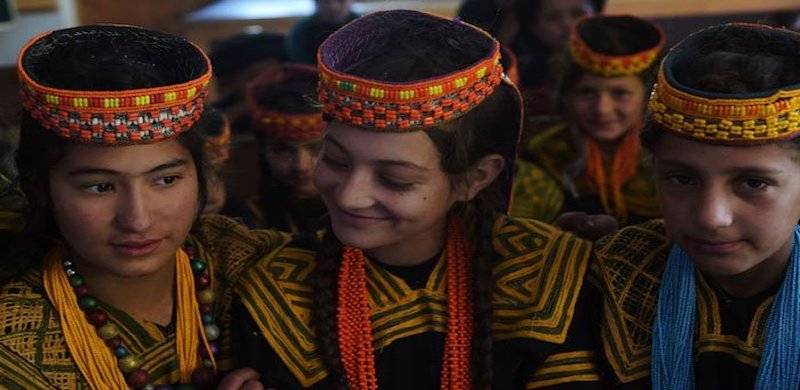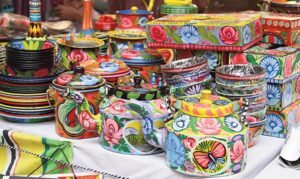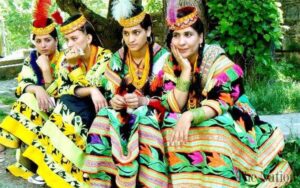
The term ‘cultural heritage’ brings to mind physical aspects referring to tangible culture – blue pottery, rilli blankets, ajrak shawls, embroidered kurtas and handwoven baskets. However, equally important is our intangible culture which includes knowledge, verbal expressions, folk lore, music, religious chants, stories, recipes and oral history. Overall, in Pakistan there is a widespread problem of the preservation of the country’s heritage with unclear policies on the promotion, development and innovation of what already exists.
Majority of the handicraft that one comes across is found in rural areas. Beyond the work of agriculture, in between to earn an income, the peasantry works on craft which falls under tangible culture. Almost directly related is the intangible culture which includes oral histories and traditions which are linked to heritage sites located in those rural areas. Modernisation of everyday living as well as industrialisation and globalisation have over time eradicated whatever little existing markets were there for these handmade products causing intangible culture to remain in the fringes as well. Mtv is far more appealing than say, singers in Bhit Shah and jeans are more popular and practical than a lungi.

Added to the dilemma are quality control and consistency. As craft depends on the availability of labour which is predominantly defined by the seasons and crops, there is a huge risk of lack of consistency in terms of output. This means that demand is inevitably affected as there is no reassurance of repeat production. As demand decreases, artisans ultimately give up the craft and consider moving to urban areas for employment. This in turn means that their children, the next generation, almost most likely never learn the craft skills and techniques causing the handicraft to fade away without ever being documented or passed on.
On the other hand, when it comes to intangible culture, due to its non-physical, untouchable feature it is harder to pinpoint the threats to it. Are the people who hold histories by memory dying? Is the lack of conservation of heritage sites causing stories and legends linked to it to fade away?
Is the rural-urban migration and the need to earn a living a reason for the loss of storytelling and folklore? Is sectarian and provincial nationalism the cause of indigenous languages and religious traditions to die out?
In 2003, UNESCO passed a convention with the aim to raise awareness of the need to preserve intangible culture and ensure it is seen as an integral part of heritage. In Pakistan right now there is an opportunity for the preservation of intangible culture. With growing national tourism as a result of Covid-19, sustainability is key – without a sustainable strategy there is a risk of tourism collapsing as a result of lack of management and eco-friendly policies.
So what can be done? Social entrepreneurship is one effective means of ensuring cultural heritages do not fade away. There are different forms of it – the most used and well known being microfinance. Others include incubators, trade shows, nonprofits and social enterprises. Enhancing social entrepreneurship at the grassroots and around heritage sites is a constructive way of ensuring intangible culture in particular remains alive. Both tangible and intangible have roots in some historic monument and/or region which in turn has its own arts and crafts. If investments are made, training sessions conducted and literacy is taught, especially digital literacy, the field of cultural heritage can get a massive boost.

With better quality control and consistency, an economic cycle can be set in place via access to wider markets and consumers through digital media. This can encourage repeat production and further cycles of training amongst communities. This creates a domino effect where the lores and legends surrounding history of that region, heritage site and even craft can be revived.
With national tourism growing and international travel becoming increasingly difficult (and expensive!), this is the time to implement policies to ensure that not only is our heritage preserved but it acts as a tool for education, training, economic activity and for advocacy of the environment. Pakistan is already facing severe climate related problems and needs whatever it can to educate its people about the environmental disaster looming. All of this ties in as a massive call for action and no one but Pakistan itself can and should do it by itself, for itself.
Majority of the handicraft that one comes across is found in rural areas. Beyond the work of agriculture, in between to earn an income, the peasantry works on craft which falls under tangible culture. Almost directly related is the intangible culture which includes oral histories and traditions which are linked to heritage sites located in those rural areas. Modernisation of everyday living as well as industrialisation and globalisation have over time eradicated whatever little existing markets were there for these handmade products causing intangible culture to remain in the fringes as well. Mtv is far more appealing than say, singers in Bhit Shah and jeans are more popular and practical than a lungi.

Added to the dilemma are quality control and consistency. As craft depends on the availability of labour which is predominantly defined by the seasons and crops, there is a huge risk of lack of consistency in terms of output. This means that demand is inevitably affected as there is no reassurance of repeat production. As demand decreases, artisans ultimately give up the craft and consider moving to urban areas for employment. This in turn means that their children, the next generation, almost most likely never learn the craft skills and techniques causing the handicraft to fade away without ever being documented or passed on.
On the other hand, when it comes to intangible culture, due to its non-physical, untouchable feature it is harder to pinpoint the threats to it. Are the people who hold histories by memory dying? Is the lack of conservation of heritage sites causing stories and legends linked to it to fade away?
Is the rural-urban migration and the need to earn a living a reason for the loss of storytelling and folklore? Is sectarian and provincial nationalism the cause of indigenous languages and religious traditions to die out?
In 2003, UNESCO passed a convention with the aim to raise awareness of the need to preserve intangible culture and ensure it is seen as an integral part of heritage. In Pakistan right now there is an opportunity for the preservation of intangible culture. With growing national tourism as a result of Covid-19, sustainability is key – without a sustainable strategy there is a risk of tourism collapsing as a result of lack of management and eco-friendly policies.
So what can be done? Social entrepreneurship is one effective means of ensuring cultural heritages do not fade away. There are different forms of it – the most used and well known being microfinance. Others include incubators, trade shows, nonprofits and social enterprises. Enhancing social entrepreneurship at the grassroots and around heritage sites is a constructive way of ensuring intangible culture in particular remains alive. Both tangible and intangible have roots in some historic monument and/or region which in turn has its own arts and crafts. If investments are made, training sessions conducted and literacy is taught, especially digital literacy, the field of cultural heritage can get a massive boost.

With better quality control and consistency, an economic cycle can be set in place via access to wider markets and consumers through digital media. This can encourage repeat production and further cycles of training amongst communities. This creates a domino effect where the lores and legends surrounding history of that region, heritage site and even craft can be revived.
With national tourism growing and international travel becoming increasingly difficult (and expensive!), this is the time to implement policies to ensure that not only is our heritage preserved but it acts as a tool for education, training, economic activity and for advocacy of the environment. Pakistan is already facing severe climate related problems and needs whatever it can to educate its people about the environmental disaster looming. All of this ties in as a massive call for action and no one but Pakistan itself can and should do it by itself, for itself.

